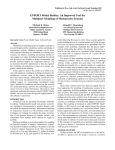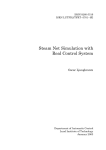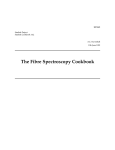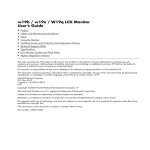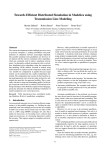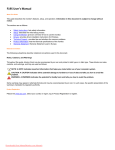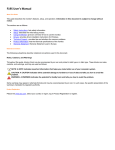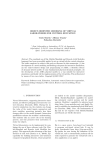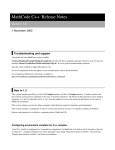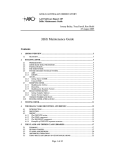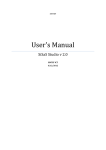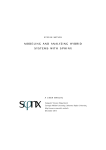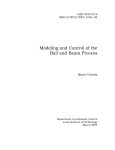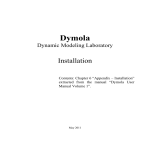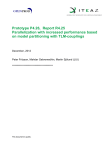Download Tutorial 1 - ModProd - Linköping University
Transcript
Introduction to Object-Oriented Modeling and Simulation with Modelica and OpenModelica Tutorial, Version Feb 03, 2015 Peter Fritzson Linköping University, [email protected] Director of the Open Source Modelica Consortium Vice Chairman of Modelica Association Mahder Gebremedhin, PhD student [email protected] Slides Based on book and lecture notes by Peter Fritzson Contributions 2004-2005 by Emma Larsdotter Nilsson, Peter Bunus Contributions 2006-2008 by Adrian Pop and Peter Fritzson Contributions 2009 by David Broman, Peter Fritzson, Jan Brugård, and Mohsen Torabzadeh-Tari Contributions 2010 by Peter Fritzson Contributions 2011 by Peter F., Mohsen T,. Adeel Asghar, Contributions 2012, 2013, 2014, 2015 by Peter Fritzson, Lena Buffoni, and Mahder Gebremedhin 2015-02-03 Tutorial Based on Book, 2004 Download OpenModelica Software Peter Fritzson Principles of Object Oriented Modeling and Simulation with Modelica 2.1 Wiley-IEEE Press, 2004, 940 pages • OpenModelica • www.openmodelica.org • Modelica Association • www.modelica.org 2 Copyright © Open Source Modelica Consortium Introductory Modelica Book September 2011 232 pages 2014 –Translations available in Chinese, Japanese, Spanish Wiley IEEE Press For Introductory Short Courses on Object Oriented Mathematical Modeling 3 Copyright © Open Source Modelica Consortium New Big Modelica Book, 2014 Peter Fritzson Principles of Object Oriented Modeling and Simulation with Modelica 3.3 A Cyber-Physical Approach Can be ordered from Wiley or Amazon Wiley-IEEE Press, 2014, 1250 pages • OpenModelica • www.openmodelica.org • Modelica Association • www.modelica.org 4 Copyright © Open Source Modelica Consortium Acknowledgements, Usage, Copyrights • If you want to use the Powerpoint version of these slides in your own course, send an email to: [email protected] • Thanks to Emma Larsdotter Nilsson, Peter Bunus, David Broman, Jan Brugård, Mohsen-Torabzadeh-Tari, Adeel Asghar, Lena Buffoni, for contributions to these slides. • Most examples and figures in this tutorial are adapted with permission from Peter Fritzson’s book ”Principles of Object Oriented Modeling and Simulation with Modelica 2.1”, copyright Wiley-IEEE Press • Some examples and figures reproduced with permission from Modelica Association, Martin Otter, Hilding Elmqvist, Wolfram MathCore, Siemens • Modelica Association: www.modelica.org • OpenModelica: www.openmodelica.org 5 Copyright © Open Source Modelica Consortium Outline Part I Introduction to Modelica and a demo example Part III Modelica language concepts and textual modeling 6 Copyright © Open Source Modelica Consortium Part II Modelica environments Part IV Graphical modeling and the Modelica standard library Detailed Schedule (afternoon version) 14:00 - Introduction to Modeling and Simulation • Start installation of OpenModelica including OMEdit graphic editor 14:10 - Modelica – The Next Generation Modeling Language 14:25 - Exercises Part I (15 minutes) • Short hands-on exercise on graphical modeling using OMEdit– RL Circuit 14:50 – Part II: Modelica Environments and the OpenModelica Environment 15:10 – Part III: Modelica Textual Modeling 15:15 - Exercises Part IIIa (30 minutes) • Hands-on exercises on textual modeling using the OpenModelica environment 15:45 – Coffee Break 16:00 - Modelica Discrete Events and Hybrid Properties 16:15 - Exercises Part IIIb (10 minutes) • Hands-on exercises on textual modeling using the OpenModelica environment 16:25 – Part IV: Components, Connectors and Connections - Modelica Libraries 16:45 - Graphical Modeling using OpenModelica 17:00 - Exercises Part IV (30 minutes) – DCMotor etc. • 7 Hands-on exercises on graphical modeling using OpenModelica Copyright © Open Source Modelica Consortium Software Installation - Windows • Start the software installation • Install OpenModelica-1.9.2beta.exe from the USB Stick 8 Copyright © Open Source Modelica Consortium Software Installation – Linux (requires internet connection) • Go to https://openmodelica.org/index.php/download/down load-linux and follow the instructions. 9 Copyright © Open Source Modelica Consortium Software Installation – MAC (requires internet connection) • Go to https://openmodelica.org/index.php/download/down load-mac and follow the instructions or follow the instructions written below. • The installation uses MacPorts. After setting up a MacPorts installation, run the following commands on the terminal (as root): • echo rsync://build.openmodelica.org/macports/ >> /opt/local/etc/macports/sources.conf # assuming you installed into /opt/local • port selfupdate • port install openmodelica-devel 10 Copyright © Open Source Modelica Consortium Part I Introduction to Modelica and a demo example 11 Copyright © Open Source Modelica Consortium Modelica Background: Stored Knowledge Model knowledge is stored in books and human minds which computers cannot access “The change of motion is proportional to the motive force impressed “ – Newton 12 Copyright © Open Source Modelica Consortium Modelica Background: The Form – Equations • Equations were used in the third millennium B.C. • Equality sign was introduced by Robert Recorde in 1557 Newton still wrote text (Principia, vol. 1, 1686) “The change of motion is proportional to the motive force impressed ” CSSL (1967) introduced a special form of “equation”: variable = expression v = INTEG(F)/m Programming languages usually do not allow equations! 13 Copyright © Open Source Modelica Consortium What is Modelica? A language for modeling of complex cyber-physical systems • • • • • • 14 Robotics Automotive Aircrafts Satellites Power plants Systems biology Copyright © Open Source Modelica Consortium What is Modelica? A language for modeling of complex cyber-physical systems Primary designed for simulation, but there are also other usages of models, e.g. optimization. 15 Copyright © Open Source Modelica Consortium What is Modelica? A language for modeling of complex cyber-physical systems i.e., Modelica is not a tool Free, open language specification: There exist several free and commercial tools, for example: • OpenModelica from OSMC • Dymola from Dassault systems • Wolfram System Modeler fr Wolfram MathCore • SimulationX from ITI • MapleSim from MapleSoft • AMESIM from LMS • JModelica.org from Modelon Available at: www.modelica.org • MWORKS from Tongyang Sw & Control • IDA Simulation Env, from Equa Developed and standardized • CyModelica Modeling tool, ESI Group by Modelica Association 16 Copyright © Open Source Modelica Consortium Modelica – The Next Generation Modeling Language Declarative language Equations and mathematical functions allow acausal modeling, high level specification, increased correctness Multi-domain modeling Combine electrical, mechanical, thermodynamic, hydraulic, biological, control, event, real-time, etc... Everything is a class Strongly typed object-oriented language with a general class concept, Java & MATLAB-like syntax Visual component programming Hierarchical system architecture capabilities Efficient, non-proprietary Efficiency comparable to C; advanced equation compilation, e.g. 300 000 equations, ~150 000 lines on standard PC 17 Copyright © Open Source Modelica Consortium Modelica Acausal Modeling What is acausal modeling/design? Why does it increase reuse? The acausality makes Modelica library classes more reusable than traditional classes containing assignment statements where the input-output causality is fixed. Example: a resistor equation: R*i = v; can be used in three ways: i := v/R; v := R*i; R := v/i; 18 Copyright © Open Source Modelica Consortium What is Special about Modelica? • Multi-Domain Modeling • Visual acausal hierarchical component modeling • Typed declarative equation-based textual language • Hybrid modeling and simulation 19 Copyright © Open Source Modelica Consortium What is Special about Modelica? Multi-Domain Modeling Cyber-Physical Modeling Physical Cyber 20 Copyright © Open Source Modelica Consortium 3 domains - electric - mechanics - control What is Special about Modelica? Multi-Domain Modeling Keeps the physical structure Acausal model (Modelica) Causal block-based model (Simulink) 21 Copyright © Open Source Modelica Consortium Visual Acausal Hierarchical Component Modeling What is Special about Modelica? Hierarchical system modeling Multi-Domain Modeling k2 i qddRef qdRef qRef 1 1 S S k1 axis6 cut joint r3Control tn r3Drive1 r3Motor i 1 qd qdRef Kd axis5 q: angle qd: angular velocity qdd: angular acceleration S rel 0.03 Jmotor=J - Kv 0.3 sum w Sum +1 +1 - rate2 rate3 b(s) 340.8 a(s) S joint=0 spring=c axis4 S iRef gear=i fric=Rv0 qRef pSum Visual Acausal Hierarchical Component Modeling axis3 tacho2 b(s) b(s) a(s) a(s) tacho1 g5 PT1 axis2 qd C=0.004*D/w m Rd1=100 Rp1=200 axis1 Rd3=100 Vs Srel = n*transpose(n)+(identity(3)n*transpose(n))*cos(q)Rd2=100 Ri=10 skew(n)*sin(q); + + wrela = n*qd; diff + pow er cut in OpI zrela = n*qdd; Sb = Sa*transpose(Srel); Rd4=100 r0b = r0a; iRef vb = Srel*va; Ra=250 La=(250/(2*D*w m)) q Rp2=50 rate1 emf g3 hall2 wb = Srel*(wa + wrela); g1 ab = Srel*aa; zb = Srel*(za + zrela + cross(wa, wrela)); y x inertial hall1 w r Courtesy of Martin Otter g2 22 qd Copyright © Open Source Modelica Consortium g4 q What is Special about Modelica? Visual Acausal Hierarchical A textual class-based language Component OO primary used for as a structuring concept Modeling Behaviour described declaratively using • Differential algebraic equations (DAE) (continuous-time) • Event triggers (discrete-time) Multi-Domain Modeling Variable declarations Typed Declarative Equation-based Textual Language 23 class VanDerPol "Van der Pol oscillator model" Real x(start = 1) "Descriptive string for x”; Real y(start = 1) "y coordinate”; parameter Real lambda = 0.3; equation der(x) = y; der(y) = -x + lambda*(1 - x*x)*y; end VanDerPol; Copyright © Open Source Modelica Consortium Differential equations What is Special about Modelica? Multi-Domain Modeling Visual Acausal Component Modeling Hybrid modeling = continuous-time + discrete-time modeling Continuous-time Discrete-time Clocked discrete-time Typed Declarative Equation-based Textual Language 24 Copyright © Open Source Modelica Consortium time Hybrid Modeling Modelica – Faster Development, Lower Maintenance than with Traditional Tools Block Diagram (e.g. Simulink, ...) or Proprietary Code (e.g. Ada, Fortran, C,...) vs Modelica Systems Definition Modeling of Subsystems System Decomposition Proprietary Code Block Diagram Modelica 25 Copyright © Open Source Modelica Consortium Causality Derivation (manual derivation of input/output relations) Implementation Simulation Modelica vs Simulink Block Oriented Modeling Simple Electrical Model Modelica: Physical model – easy to understand Keeps the physical structure Simulink: Signal-flow model – hard to understand Res2 p p R2 sum3 -1 1 Ind 1/L l2 1 s R2=100 R1=10 sum2 p +1 n n +1 AC=220 p p n sum1 +1 -1 C=0.01 L=0.1 n n p G 26 sinln Copyright © Open Source Modelica Consortium Res1 1/R1 Cap 1/C l1 1 s Graphical Modeling - Using Drag and Drop Composition 27 Copyright © Open Source Modelica Consortium Multi-Domain (Electro-Mechanical) Modelica Model • A DC motor can be thought of as an electrical circuit which also contains an electromechanical component model DCMotor Resistor R(R=100); Inductor L(L=100); VsourceDC DC(f=10); Ground G; ElectroMechanicalElement EM(k=10,J=10, b=2); Inertia load; equation R L connect(DC.p,R.n); connect(R.p,L.n); DC connect(L.p, EM.n); connect(EM.p, DC.n); connect(DC.n,G.p); connect(EM.flange,load.flange); G end DCMotor 28 Copyright © Open Source Modelica Consortium EM load Corresponding DCMotor Model Equations The following equations are automatically derived from the Modelica model: (load component not included) Automatic transformation to ODE or DAE for simulation: 29 Copyright © Open Source Modelica Consortium Model Translation Process to Hybrid DAE to Code Modelica Graphical Editor Modelica Textual Editor Modelica Model Modelica Model Frontend Modeling Environment Modelica Source code Translator Flat model Hybrid DAE "Middle-end" Analyzer Sorted equations Optimizer Backend Optimized sorted equations Code generator C Code C Compiler Executable Simulation 30 Copyright © Open Source Modelica Consortium Modelica in Power Generation GTX Gas Turbine Power Cutoff Mechanism Hello Courtesy of Siemens Industrial Turbomachinery AB 31 Copyright © Open Source Modelica Consortium Developed by MathCore for Siemens Modelica in Automotive Industry 32 Copyright © Open Source Modelica Consortium Modelica in Avionics 33 Copyright © Open Source Modelica Consortium Modelica in Biomechanics 34 Copyright © Open Source Modelica Consortium Application of Modelica in Robotics Models Real-time Training Simulator for Flight, Driving • Using Modelica models generating real-time code • Different simulation environments (e.g. Flight, Car Driving, Helicopter) • Developed at DLR Munich, Germany • Dymola Modelica tool Courtesy of Martin Otter, DLR, Oberphaffenhofen, Germany 35 Copyright © Open Source Modelica Consortium Combined-Cycle Power Plant Plant model – system level • GT unit, ST unit, Drum boilers unit and HRSG units, connected by thermo-fluid ports and by signal buses • Low-temperature parts (condenser, feedwater system, LP circuits) are represented by trivial boundary conditions. • GT model: simple law relating the electrical load request with the exhaust gas temperature and flow rate. Courtesy Francesco Casella, Politecnico di Milano – Italy and Francesco Pretolani, CESI SpA - Italy 36 Copyright © Open Source Modelica Consortium Modelica Spacecraft Dynamics Library Formation flying on elliptical orbits Control the relative motion of two or more spacecraft Attitude control for satellites using magnetic coils as actuators Torque generation mechanism: interaction between coils and geomagnetic field Courtesy of Francesco Casella, Politecnico di Milano, Italy 37 Copyright © Open Source Modelica Consortium System Dynamics – World Society Simulation Limits to Material Growth; Population, Energy and Material flows Left. World3 simulation with OpenModelica • 2 collapse scenarios (close to current developments) • 1 sustainable scenario (green). CO2 Emissions per person: • USA 17 ton/yr • Sweden 7 ton/yr • India 1.4 ton/yr • Bangladesh 0.3 ton/yr • • • • 38 System Dynamics Modelica library by Francois Cellier (ETH), et al in OM distribution. Warming converts many agriculture areas to deserts (USA, Europe, India, Amazonas) Ecological breakdown around 2080-2100, drastic reduction of world population To avoid this: Need for massive investments in sustainable technology and renewable energy sources Copyright © Open Source Modelica Consortium What Can You Do? Need Global Sustainability Mass Movement • • • • Book: Current catastrophic scenarios: Mark Lynas: ”6 Degrees” Book: How to address the problems: Tim Jackson ”Prosperity without Growth” Promote sustainable lifestyle and technology Install electric solar PV panels Buy shares in cooperative wind power 20 sqm solar panels on garage roof, Nov 2012 Generated 2700 W at noon March 10, 2013 39 Copyright © Open Source Modelica Consortium Expanded to 93 sqm, 12 kW, March 2013 House produced 11600 kwh, used 9500 kwh Avoids 10 ton CO2 emission per year Example Electric Cars Can be charged by electricity from own solar panels Renault ZOE; 5 seat; Range: • EU-drive cycle 210 km • Realistic Swedish drive cycle: • Summer: 165 km • Winter: 100 – 110 km Cheap fast supercharger DLR ROboMObil • experimental electric car • Modelica models 40 Copyright © Open Source Modelica Consortium Tesla model S range 480 km Small rectangles – surface needed for 100% solar energy for humanity Good News Year 2013 –China installed 12Gw, production 14 Twh/yr More than doubling capacity. Germany installed 3.3 Gw 41 Copyright © Open Source Modelica Consortium Sustainable Society Necessary for Human Survival Almost Sustainable • India, 1.4 ton C02/person/year • Healthy vegetarian food • Small-scale agriculture • Small-scale shops • Simpler life-style (Mahatma Gandhi) Non-sustainable • USA 17 ton CO2, Sweden 7 ton CO2/yr • High meat consumption (1 kg beef uses ca 4000 L water for production) • Hamburgers, unhealthy , includes beef • Energy-consuming mechanized agriculture • Transport dependent shopping centres • Stressful materialistic lifestyle 42 Copyright © Open Source Modelica Consortium Gandhi – role model for future less materialistic life style Brief Modelica History • First Modelica design group meeting in fall 1996 • International group of people with expert knowledge in both language design and physical modeling • Industry and academia • Modelica Versions • • • • • • • • • 1.0 released September 1997 2.0 released March 2002 2.2 released March 2005 3.0 released September 2007 3.1 released May 2009 3.2 released March 2010 3.3 released May 2012 3.2 rev 2 released November 2013 3.3 rev 1 released July 2014 • Modelica Association established 2000 in Linköping • Open, non-profit organization 43 Copyright © Open Source Modelica Consortium Modelica Conferences • • • • • • • • • • • 44 The 1st International Modelica conference October, 2000 The 2nd International Modelica conference March 18-19, 2002 The 3rd International Modelica conference November 5-6, 2003 in Linköping, Sweden The 4th International Modelica conference March 6-7, 2005 in Hamburg, Germany The 5th International Modelica conference September 4-5, 2006 in Vienna, Austria The 6th International Modelica conference March 3-4, 2008 in Bielefeld, Germany The 7th International Modelica conference Sept 21-22, 2009 in Como, Italy The 8th International Modelica conference March 20-22, 2011 in Dresden, Germany The 9th International Modelica conference Sept 3-5, 2012 in Munich, Germany The 10th International Modelica conference March 10-12, 2014 in Lund, Sweden Coming: 11th International Modelica conference Sept 21-23, 2015 in Paris Copyright © Open Source Modelica Consortium Exercises Part I Hands-on graphical modeling (15 minutes) 45 Copyright © Open Source Modelica Consortium Exercises Part I – Basic Graphical Modeling • • • • (See instructions on next two pages) Start the OMEdit editor (part of OpenModelica) Draw the RLCircuit Simulate R1 L R=10 R=100 L=1 L=0.1 AC The RLCircuit G 46 Copyright © Open Source Modelica Consortium Simulation Exercises Part I – OMEdit Instructions (Part I) • Start OMEdit from the Program menu under OpenModelica • Go to File menu and choose New, and then select Model. • E.g. write RLCircuit as the model name. • For more information on how to use OMEdit, go to Help and choose User Manual or press F1. • Under the Modelica Library: • Contains The standard Modelica library components • The Modelica files contains the list of models you have created. 47 Copyright © Open Source Modelica Consortium Exercises Part I – OMEdit Instructions (Part II) • For the RLCircuit model, browse the Modelica standard library and add the following component models: • Add Ground, Inductor and Resistor component models from Modelica.Electrical.Analog.Basic package. • Add SineVoltage component model from Modelica.Electrical.Analog.Sources package. • Make the corresponding connections between the component models as shown in slide 38. • Simulate the model • Go to Simulation menu and choose simulate or click on the simulate button in the toolbar. • Plot the instance variables • 48 Once the simulation is completed, a plot variables list will appear on the right side. Select the variable that you want to plot. Copyright © Open Source Modelica Consortium Part II Modelica environments and OpenModelica 49 Copyright © Open Source Modelica Consortium Wolfram System Modeler – Wolfram MathCore • • • • • • Wolfram Research USA, Sweden General purpose Mathematica integration www.wolfram.com www.mathcore.com Mathematica Courtesy Wolfram Research 50 Car model graphical view Copyright © Open Source Modelica Consortium Simulation and analysis Dymola • • • • • 51 Copyright © Open Source Modelica Consortium Dassault Systemes Sweden Sweden First Modelica tool on the market Initial main focus on automotive industry www.dymola.com Simulation X • • • • 52 Copyright © Open Source Modelica Consortium ITI Germany Mechatronic systems www.simulationx.com MapleSim • • • • • 53 Copyright © Open Source Modelica Consortium Maplesoft Canada Recent Modelica tool on the market Integrated with Maple www.maplesoft.com The OpenModelica Environment www.OpenModelica.org 54 Copyright © Open Source Modelica Consortium The OpenModelica Open Source Environment www.openmodelica.org • Advanced Interactive Modelica compiler (OMC) • • Supports most of the Modelica Language Modelica and Python scripting • Basic environment for creating models • • • 55 OMShell – an interactive command handler OMNotebook – a literate programming notebook MDT – an advanced textual environment in Eclipse Copyright © Open Source Modelica Consortium • OMEdit graphic Editor • OMDebugger for equations • OMOptim optimization tool • OM Dynamic optimizer collocation • ModelicaML UML Profile • MetaModelica extension • ParModelica extension 55 OSMC – International Consortium for Open Source Model-based Development Tools, 46 members Mar 2014 Founded Dec 4, 2007 Open-source community services • • • • • Website and Support Forum Version-controlled source base Bug database Development courses www.openmodelica.org Code Statistics Industrial members • Bosch Rexroth AG, Germany •Siemens PLM, California, USA •Siemens Turbo, Sweden • CDAC Centre, Kerala, India • Creative Connections, Prague • DHI, Aarhus, Denmark • EDF, Paris, France • Equa Simulation AB, Sweden • Fraunhofer IWES, Bremerhaven • Frontway AB, Sweden • IFP, Paris, France University members • Austrian Inst. of Tech, Austria • Linköping University, Sweden • UC Berkeley, USA •TU Berlin, Insti UEBB, Germany • FH Bielefeld, Bielefeld, Germany •TU Braunschweig, Germany • Univ Calabria, Italy • Danish Technical Univ, Denmark •TU Dortmund, Germany •TU Dresden, Germany • Université Laval, Canada • Georgia Inst. Technology, USA 56 Copyright © Open Source Modelica Consortium • GTI, USA • ISID Dentsu, Tokyo, Japan • ITI, Dresden, Germany • Maplesoft, Canada • Ricardo Inc., USA • STEAG, Dehli, India •TLK Thermo, Germany •Sozhou Tongyuan, China • VTI, Linköping, Sweden • VTT, Finland • Wolfram MathCore, Sweden • Ghent University, Belgium • Halmstad University, Sweden • Heidelberg University, Germany • TU Hamburg/Harburg Germany • KTH, Stockholm, Sweden • Univ of Maryland, Syst Eng USA • Univ of Maryland, CEEE, USA • Politecnico di Milano, Italy • Ecoles des Mines, CEP, France • Mälardalen University, Sweden • Univ Pisa, Italy •Telemark Univ College, Norway OMNotebook Electronic Notebook with DrModelica • • • Primarily for teaching Interactive electronic book Platform independent Commands: • Shift-return (evaluates a cell) • File Menu (open, close, etc.) • Text Cursor (vertical), Cell cursor (horizontal) • Cell types: text cells & executable code cells • Copy, paste, group cells • Copy, paste, group text • Command Completion (shifttab) 57 Copyright © Open Source Modelica Consortium OMnotebook Interactive Electronic Notebook Here Used for Teaching Control Theory 58 Copyright © Open Source Modelica Consortium OpenModelica Environment Demo 59 Copyright © Open Source Modelica Consortium OpenModelica MDT – Eclipse Plugin • Browsing of packages, classes, functions • Automatic building of executables; separate compilation • Syntax highlighting • Code completion, Code query support for developers • Automatic Indentation • Debugger (Prel. version for algorithmic subset) 60 Copyright © Open Source Modelica Consortium OpenModelica MDT: Code Outline and Hovering Info Identifier Info on Hovering Code Outline for 61 easy navigation within Modelica files Copyright © Open Source Modelica Consortium 61 OpenModelica MDT Algorithmic Code Debugger 62 Copyright © Open Source Modelica Consortium The OpenModelica MDT Debugger (Eclipse-based) Using Japanese Characters 63 Copyright © Open Source Modelica Consortium OpenModelica Equation Model Debugger Showing equation transformations of a model: 0 = y + der(x * time * z); z = 1.0; (1) substitution: y + der(x * (time * z)) => y + der(x * (time * 1.0)) (2) simplify: y + der(x * (time * 1.0)) => y + der(x * time) (3) expand derivative (symbolic diff): y + der(x * time) =>y + (x + der(x) * time) Mapping run-time error to source model position 64 Copyright © Open Source Modelica Consortium (4) solve: 0.0 = y + (x + der(x) * time) => der(x) = ((-y) - x) / time time <> 0 OpenModelica Simulation in Web Browser Client MultiBody RobotR3.FullRobot OpenModelica compiles to efficient Java Script code which is executed in web browser 65 Copyright © Open Source Modelica Consortium Interactive Simulation Examples of Simulation Visualization Simulation Control Simulation Center Plot View Source.flowLevel 0.02 tank1.area Requirements View 1.0 File Edit Requirements Source.flowLevel 1.3 Status Info Req.001: tank1 Violation warning Req.001: tank2 Violated Req.002: source OK Pause 1. Start Time: 22 (sec) | End Time: 50 (sec) Start Value: tank1 = 8 (m) Maximum Value: tank1 = 15 (m) 2. Start Time: 95 (sec) | End Time: 110 (sec) Start Value: tank1 = 8 (m) Maximum Value: tank1 = 11 (m) Click for more information about this Requirement Start History Show violations (2) Stop Requirements Evaluation View in ModelicaML Status: Simulation is running... Simulation Time: 00:01:56:220 Status: Simulation is running... Formulartitel MaxLevel Liquid Source Level h Level h Tank 1 Status: Simulation is running... 66 Copyright © Open Source Modelica Consortium Tank 2 Domain-Specific Visualization View OMPython – Python Scripting with OpenModelica • • • • • • 67 Interpretation of Modelica commands and expressions Interactive Session handling Library / Tool Optimized Parser results Helper functions Deployable, Extensible and Distributable Copyright © Open Source Modelica Consortium PySimulator Package • PySimulator, a simulation and analysis package developed by DLR • Free, downloadable • Uses OMPython to simulate Modelica models by OpenModelica 68 Copyright © Open Source Modelica Consortium Modelica3D Library • Modelica 3D Graphics Library by Fraunhofer FIRST, Berlin • Part of OpenModelica distribution • Can be used for 3D graphics in OpenModelica 69 Copyright © Open Source Modelica Consortium Extending Modelica with PDEs for 2D, 3D flow problems – Research Insulated boundary: class PDEModel HeatNeumann h_iso; Dirichlet h_heated(g=50); HeatRobin h_glass(h_heat=30000); HeatTransfer ht; Rectangle2D dom; equation dom.eq=ht; dom.left.bc=h_glass; dom.top.bc=h_iso; dom.right.bc=h_iso; dom.bottom.bc=h_heated; end PDEModel; Prototype in OpenModelica 2005 PhD Thesis by Levon Saldamli www.openmodelica.org Currently not operational 70 Copyright © Open Source Modelica Consortium Poorly insulated boundary: Tinf 20 Conducting boundary: u 60 OMOptim – Optimization (1) Model structure 71 Model Variables Copyright © Open Source Modelica Consortium Optimized parameters Optimized Objectives Problems OMOptim – Optimization (2) Solved problems 72 Copyright © Open Source Modelica Consortium Result plot Export result data .csv Multiple-Shooting and Collocation Dynamic Trajectory Optimization • Minimize a goal function subject to model equation constraints, useful e.g. for NMPC • Multiple Shooting/Collocation • In OpenModelica 1.9.1 beta release Jan 2014. Solve sub-problem in each sub-interval Example speedup, 16 cores: MULTIPLE_COLLOCATION 16.0 14.0 12.0 10.0 8.0 6.0 4.0 2.0 0.0 1 2 ipopt [scaled] 73 Copyright © Open Source Modelica Consortium 4 8 jac_g [scaled] 16 OpenModelica Dynamic Optimization Collocation 74 Copyright © Open Source Modelica Consortium General Tool Interoperability & Model Exchange Functional Mock-up Interface (FMI) etc. Engine with ECU Gearbox with ECU Thermal systems Automated Chassis components, cargo door roadway, ECU (e.g. ESP) functional mockup interface for model exchange and tool coupling courtesy Daimler • FMI development was started by ITEA2 MODELISAR project. FMI is a Modelica Association Project now • Version 1.0 • FMI for Model Exchange (released Jan 26,2010) • FMI for Co-Simulation (released Oct 12,2010) • Version 2.0 • FMI for Model Exchange and Co-Simulation (released July 25,2014) • > 50 tools supporting it (https://www.fmi-standard.org/tools) 75 Copyright © Open Source Modelica Consortium Functional Mockup Units – FMUs • Import and export of input/output blocks – Functional Mock-Up Units – FMUs, described by • differential-, algebraic-, discrete equations, • with time-, state, and step-events • An FMU can be large (e.g. 100 000 variables) • An FMU can be used in an embedded system (small overhead) • FMUs can be connected together 76 Copyright © Open Source Modelica Consortium FMI in OpenModelica • Model Exchange implemented (FMI 1.0 and FMI 2.0) • FMI 2.0 Co-simulation is under development. A prototype of FMI 2.0 including tool co-simulation is available • Ongoing work to support full FMI 2.0 • The FMI interface is accessible via the OpenModelica scripting environment and the OpenModelica connection editor 77 Copyright © Open Source Modelica Consortium OPENPROD – Large 28-partner European Project, 2009-2012 Vision of Cyber-Physical Model-Based Product Development Feedback Business Business Process Process Control Control Requirements Requirements Capture Capture Model-Driven Driven Model Design Design (PIM) Compilation Compilation & & Code Code Gen Gen (PSM) System System Simulation Simulation Software Software&& Syst Product System Product Process Process models models Requirements Requirements models models Product Product models models Platform Platform models models Unified Modeling: Meta -modeling& Modelica& UML & OWL OPENPROD Vision of unified modeling framework for model-based product development. Open Standards – Modelica (HW, SW) and UML (SW) 78 Copyright © Open Source Modelica Consortium OPENPROD Model-Based Development Environment Covers Product-Design V Feedback System System Simulation Simulation Business B usiness Process Process Control Control Requirements Requirements Capture Capture Requirements Requirements models models Process Process models models Model- Driven Model Driven Design Design (PIM) Product Product models models Compilat ion Compilation & Code Gen & Code Gen (PSM) Software Software&& Syst Product System Product Platform Platform models models Unified Modeling: Meta- modeling& Modelica& UML& OWL Level of Abstraction Experience Feedback Maintenance System requirements Calibration Specification Product verification and deployment Preliminary feature design Design Integration Subsystem level integration test calibration and verification Architectural design and Subsystem level integration and Design system functional design Refinement Verification verification Detailed feature design and Component verification implementation Realization 79 Copyright © Open Source Modelica Consortium Documentation, Version and Configuration Management Business Process Control and Modeling Feedback System System Simulation Simulation Business B usiness Process Process Control Control Requirements Requirements Capture Capture Model- Driven Model Driven Design Design (PIM) Compilat ion Compilation & Code Code Gen Gen & (PSM) VTT Simantics Business process modeler Software Software&& Syst Product System Product Process Process models models Requirements Requirements models models Product Product models models Platform Platform models models OpenModelica compiler & simulator Unified Modeling: Meta- modeling& Modelica& UML & OWL OpenModelica based simulation Metso Business model & simulation VTT Simantics Graphic Modeling To Simulation of 3 strategies with outcomes 80 Copyright © Open Source Modelica Consortium Requirement Capture Feedback System System Simulation Simulation Business B usiness Process Process Control Control Model- Driven Model Driven Design Design (PIM) Requirements Requirements Capture Capture Compilat ion Compilation & Code Code Gen Gen & (PSM) vVDR (virtual Verification of Designs against Requirements) Software Software&& Syst Product System Product Process Process models models Requirements Requirements models models Product Product models models Platform Platform models models in ModelicaML UML/Modelica Profile, part of OpenModelica Unified Modeling: Meta- modeling& Modelica& UML & OWL OpenModelica based simulation Verification Model Provider from design model Design Model Scenario Model Binding Requirement Models Client from requirement model 81 Copyright © Open Source Modelica Consortium OpenModelica – ModelicaML UML Profile SysML/UML to Modelica OMG Standardization • ModelicaML is a UML Profile for SW/HW modeling • Applicable to “pure” UML or to other UML profiles, e.g. SysML • Standardized Mapping UML/SysML to Modelica • Defines transformation/mapping for executable models • Being standardized by OMG • ModelicaML • Defines graphical concrete syntax (graphical notation for diagram) for representing Modelica constructs integrated with UML • Includes graphical formalisms (e.g. State Machines, Activities, Requirements) • Which do not exist in Modelica language • Which are translated into executable Modelica code • Is defined towards generation of executable Modelica code • Current implementation based on the Papyrus UML tool + OpenModelica 82 Copyright © Open Source Modelica Consortium Example: Simulation and Requirements Evaluation Req. 001 is instantiated 2 times (there are 2 tanks in the system) tank-height is 0.6m Req. 001 for the tank2 is violated Req. 001 for the tank1 is not violated 83 Copyright © Open Source Modelica Consortium vVDR Method – virtual Verification of Designs vs Requirements Actor AUTOMATED AUTOMATED Task Created Artifact RMM Formalize Designs DAM Formalize Scenarios SM Scenario Models VM Verification Models Create Verification* Designs Alternative Models Models Execute and Create Report Analyze Results 84 Requirement Monitor Models Formalize Requirements Copyright © Open Source Modelica Consortium Reports Goal: Enable on-demand verification of designs against requirements using automated model composition at any time during development. Part III Modelica language concepts and textual modeling Typed Declarative Equation-based Textual Language 85 Copyright © Open Source Modelica Consortium Hybrid Modeling Acausal Modeling The order of computations is not decided at modeling time Acausal Causal Visual Component Level Equation Level 86 A resistor equation: R*i = v; Copyright © Open Source Modelica Consortium Causal possibilities: i := v/R; v := R*i; R := v/i; Typical Simulation Process 87 Copyright © Open Source Modelica Consortium Simple model - Hello World! Equation: x’ = - x Initial condition: x(0) = 1 Name of model Initial condition model HelloWorld "A simple equation" Real x(start=1); parameter Real a = -1; equation der(x)= a*x; end HelloWorld; Continuous-time variable Parameter, constant during simulation Simulation in OpenModelica environment Differential equation 1 0.8 simulate(HelloWorld, stopTime = 2) plot(x) 0.6 0.4 0.2 0.5 88 1 1.5 2 Copyright © Open Source Modelica Consortium Modelica Variables and Constants • Built-in primitive data types Boolean true or false Integer Integer value, e.g. 42 or –3 Real Floating point value, e.g. 2.4e-6 String String, e.g. “Hello world” Enumeration Enumeration literal e.g. ShirtSize.Medium • Parameters are constant during simulation • Two types of constants in Modelica • constant • parameter 89 constant constant constant parameter Copyright © Open Source Modelica Consortium Real String Integer Real PI=3.141592653589793; redcolor = "red"; one = 1; mass = 22.5; A Simple Rocket Model Rocket apollo13 thrust mg new model parameters (changeable before the simulation) floating point type differentiation with regards to time 90 thrust mass gravity mass mass massLossRate abs thrust acceleration altitude velocity velocity acceleration class Rocket "rocket class" parameter String name; Real mass(start=1038.358); Real altitude(start= 59404); Real velocity(start= -2003); Real acceleration; Real thrust; // Thrust force on rocket Real gravity; // Gravity forcefield parameter Real massLossRate=0.000277; equation (thrust-mass*gravity)/mass = acceleration; der(mass) = -massLossRate * abs(thrust); der(altitude) = velocity; der(velocity) = acceleration; end Rocket; Copyright © Open Source Modelica Consortium declaration comment start value name + default value mathematical equation (acausal) Celestial Body Class A class declaration creates a type name in Modelica class CelestialBody constant Real parameter Real parameter String parameter Real end CelestialBody; g = 6.672e-11; radius; name; mass; An instance of the class can be declared by prefixing the type name to a variable name ... CelestialBody moon; ... The declaration states that moon is a variable containing an object of type CelestialBody 91 Copyright © Open Source Modelica Consortium Moon Landing Rocket apollo13 thrust mg altitude only access inside the class access by dot notation outside the class 92 apollo. gravity moon. g moon.mass apollo.altitude moon.radius2 CelestialBody class MoonLanding parameter Real force1 = 36350; parameter Real force2 = 1308; protected parameter Real thrustEndTime = 210; parameter Real thrustDecreaseTime = 43.2; public Rocket apollo(name="apollo13"); CelestialBody moon(name="moon",mass=7.382e22,radius=1.738e6); equation apollo.thrust = if (time < thrustDecreaseTime) then force1 else if (time < thrustEndTime) then force2 else 0; apollo.gravity=moon.g*moon.mass/(apollo.altitude+moon.radius)^2; end MoonLanding; Copyright © Open Source Modelica Consortium Simulation of Moon Landing simulate(MoonLanding, stopTime=230) plot(apollo.altitude, xrange={0,208}) plot(apollo.velocity, xrange={0,208}) 30000 50 25000 100 150 200 -100 20000 -200 15000 10000 -300 5000 -400 50 100 150 200 It starts at an altitude of 59404 (not shown in the diagram) at time zero, gradually reducing it until touchdown at the lunar surface when the altitude is zero 93 Copyright © Open Source Modelica Consortium The rocket initially has a high negative velocity when approaching the lunar surface. This is reduced to zero at touchdown, giving a smooth landing Specialized Class Keywords • Classes can also be declared with other keywords, e.g.: model, record, block, connector, function, ... • Classes declared with such keywords have specialized properties • Restrictions and enhancements apply to contents of specialized classes • After Modelica 3.0 the class keyword means the same as model • Example: (Modelica 2.2). A model is a class that cannot be used as a connector class • Example: A record is a class that only contains data, with no equations • Example: A block is a class with fixed input-output causality model CelestialBody constant Real parameter Real parameter String parameter Real end CelestialBody; 94 Copyright © Open Source Modelica Consortium g = 6.672e-11; radius; name; mass; Modelica Functions • Modelica Functions can be viewed as a specialized class with some restrictions and extensions • A function can be called with arguments, and is instantiated dynamically when called • := means assignment function sum input Real arg1; input Real arg2; output Real result; algorithm result := arg1+arg2; end sum; 95 Copyright © Open Source Modelica Consortium Function Call – Example Function with for-loop Example Modelica function call: ... p = polynomialEvaluator({1,2,3,4},21) function PolynomialEvaluator input Real A[:]; // array, size defined // at function call time input Real x := 1.0;// default value 1.0 for x output Real sum; protected Real xpower; // local variable xpower algorithm sum := 0; xpower := 1; for i in 1:size(A,1) loop sum := sum + A[i]*xpower; xpower := xpower*x; end for; end PolynomialEvaluator; 96 Copyright © Open Source Modelica Consortium {1,2,3,4} becomes the value of the coefficient vector A, and 21 becomes the value of the formal parameter x. The function PolynomialEvaluator computes the value of a polynomial given two arguments: a coefficient vector A and a value of x. Inheritance parent class to Color restricted kind of class without equations child class or subclass keyword denoting inheritance record ColorData parameter Real red = 0.2; parameter Real blue = 0.6; Real green; end ColorData; class Color extends ColorData; equation red + blue + green = 1; end Color; class ExpandedColor parameter Real red=0.2; parameter Real blue=0.6; Real green; equation red + blue + green = 1; end ExpandedColor; Data and behavior: field declarations, equations, and certain other contents are copied into the subclass 97 Copyright © Open Source Modelica Consortium Multiple Inheritance Multiple Inheritance is fine – inheriting both geometry and color class Color parameter Real red=0.2; parameter Real blue=0.6; Real green; equation red + blue + green = 1; end Color; class Point Real x; Real y,z; end Point; multiple inheritance class ColoredPointWithoutInheritance Real x; Real y, z; parameter Real red = 0.2; parameter Real blue = 0.6; Real green; equation red + blue + green = 1; end ColoredPointWithoutInheritance; 98 Copyright © Open Source Modelica Consortium class ColoredPoint extends Point; extends Color; end ColoredPoint; Equivalent to Multiple Inheritance cont’ Only one copy of multiply inherited class Point is kept class Point Real x; Real y; end Point; class VerticalLine extends Point; Real vlength; end VerticalLine; Diamond Inheritance class Rectangle extends VerticalLine; extends HorizontalLine; end Rectangle; 99 Copyright © Open Source Modelica Consortium class HorizontalLine extends Point; Real hlength; end HorizontalLine; Simple Class Definition • Simple Class Definition • Shorthand Case of Inheritance • Example: • Often used for introducing new names of types: class SameColor = Color; type Resistor = Real; Equivalent to: connector MyPin = Pin; inheritance 100 class SameColor extends Color; end SameColor; Copyright © Open Source Modelica Consortium Inheritance Through Modification • Modification is a concise way of combining inheritance with declaration of classes or instances • A modifier modifies a declaration equation in the inherited class • Example: The class Real is inherited, modified with a different start value equation, and instantiated as an altitude variable: ... Real altitude(start= 59404); ... 101 Copyright © Open Source Modelica Consortium The Moon Landing - Example Using Inheritance (I) Rocket apollo13 thrust mg altitude CelestialBody model Body "generic body" Real mass; String name; end Body; model CelestialBody extends Body; constant Real g = 6.672e-11; parameter Real radius; end CelestialBody; 102 Copyright © Open Source Modelica Consortium model Rocket "generic rocket class" extends Body; parameter Real massLossRate=0.000277; Real altitude(start= 59404); Real velocity(start= -2003); Real acceleration; Real thrust; Real gravity; equation thrust-mass*gravity= mass*acceleration; der(mass)= -massLossRate*abs(thrust); der(altitude)= velocity; der(velocity)= acceleration; end Rocket; The Moon Landing - Example using Inheritance (II) inherited parameters model MoonLanding parameter Real force1 = 36350; parameter Real force2 = 1308; parameter Real thrustEndTime = 210; parameter Real thrustDecreaseTime = 43.2; Rocket apollo(name="apollo13", mass(start=1038.358) ); CelestialBody moon(mass=7.382e22,radius=1.738e6,name="moon"); equation apollo.thrust = if (time<thrustDecreaseTime) then force1 else if (time<thrustEndTime) then force2 else 0; apollo.gravity =moon.g*moon.mass/(apollo.altitude+moon.radius)^2; end Landing; 103 Copyright © Open Source Modelica Consortium Inheritance of Protected Elements If an extends-clause is preceded by the protected keyword, all inherited elements from the superclass become protected elements of the subclass class Point Real x; Real y,z; end Point; class Color Real red; Real blue; Real green; equation red + blue + green = 1; end Color; The inherited fields from Point keep their protection status since that extends-clause is preceded by public A protected element cannot be accessed via dot notation! 104 Copyright © Open Source Modelica Consortium class ColoredPoint protected extends Color; public extends Point; end ColoredPoint; Equivalent to class ColoredPointWithoutInheritance Real x; Real y,z; protected Real red; protected Real blue; protected Real green; equation red + blue + green = 1; end ColoredPointWithoutInheritance; Exercises Part II (30 minutes) 105 Copyright © Open Source Modelica Consortium Exercises Part II • Start OMNotebook (part of OpenModelica) • Start->Programs->OpenModelica->OMNotebook • Open File: Exercises-ModelicaTutorial.onb from the directory you copied your tutorial files to. • Note: The DrModelica electronic book has been automatically opened when you started OMNotebook. • Open Exercises-ModelicaTutorial.pdf (also available in printed handouts) 106 Copyright © Open Source Modelica Consortium Exercises 2.1 and 2.2 (See also next two pages) • Open the Exercises-ModelicaTutorial.onb found in the Tutorial directory you copied at installation. • Exercise 2.1. Simulate and plot the HelloWorld example. Do a slight change in the model, re-simulate and re-plot. Try command-completion, val( ), etc. class HelloWorld "A simple equation" Real x(start=1); simulate(HelloWorld, stopTime = 2) equation plot(x) der(x)= -x; end HelloWorld; • Locate the VanDerPol model in DrModelica (link from Section 2.1), using OMNotebook! • Exercise 2.2: Simulate and plot VanDerPol. Do a slight change in the model, re-simulate and re-plot. 107 Copyright © Open Source Modelica Consortium Exercise 2.1 – Hello World! A Modelica “Hello World” model Equation: x’ = - x Initial condition: x(0) = 1 class HelloWorld "A simple equation” parameter Real a=-1; Real x(start=1); equation der(x)= a*x; end HelloWorld; Simulation in OpenModelica environment 1 simulate(HelloWorld, stopTime = 2) plot(x) 0.8 0.6 0.4 0.2 0.5 108 1 1.5 2 Copyright © Open Source Modelica Consortium Exercise 2.2 – Van der Pol Oscillator class VanDerPol "Van der Pol oscillator model" Real x(start = 1) "Descriptive string for x"; // Real y(start = 1) "y coordinate"; // parameter Real lambda = 0.3; equation der(x) = y; // This is the der(y) = -x + lambda*(1 - x*x)*y; /* This is the end VanDerPol; x starts at 1 y starts at 1 1st diff equation // 2nd diff equation */ 2 simulate(VanDerPol,stopTime = 25) plotParametric(x,y) 1 -2 -1 1 -1 -2 109 Copyright © Open Source Modelica Consortium 2 Exercise 2.3 – DAE Example Include algebraic equation Algebraic equations contain no derivatives Exercise: Locate in DrModelica. Simulate and plot. Change the model, simulate+plot. class DAEexample Real x(start=0.9); Real y; equation der(y)+(1+0.5*sin(y))*der(x) = sin(time); x - y = exp(-0.9*x)*cos(y); end DAEexample; Simulation in OpenModelica environment 1.20 simulate(DAEexample, stopTime = 1) plot(x) 1.15 1.10 1.05 time 1.0 0.95 0.2 0.4 0.6 0.8 1 0.90 110 Copyright © Open Source Modelica Consortium Exercise 2.4 – Model the system below • Model this Simple System of Equations in Modelica 111 Copyright © Open Source Modelica Consortium Exercise 2.5 – Functions • a) Write a function, sum2, which calculates the sum of Real numbers, for a vector of arbitrary size. • b) Write a function, average, which calculates the average of Real numbers, in a vector of arbitrary size. The function average should make use of a function call to sum2. 112 Copyright © Open Source Modelica Consortium Discrete Events and Hybrid Systems Picture: Courtesy Hilding Elmqvist 113 Copyright © Open Source Modelica Consortium Hybrid Modeling Hybrid modeling = continuous-time + discrete-time modeling Continuous-time Discrete-time Events • • • • 114 Real x; Voltage v; Current i; discrete Real x; Integer i; Boolean b; time A point in time that is instantaneous, i.e., has zero duration An event condition so that the event can take place A set of variables that are associated with the event Some behavior associated with the event, e.g. conditional equations that become active or are deactivated at the event Copyright © Open Source Modelica Consortium Event Creation – if if-equations, if-statements, and if-expressions if <condition> then <equations> elseif <condition> then <equations> else <equations> end if; 115 model Diode "Ideal diode" extends TwoPin; Real s; Boolean off; equation off = s < 0; if off then v=s else v=0; end if; i = if off then 0 else s; end Diode; Copyright © Open Source Modelica Consortium true if s<0 if-equation choosing equation for v if-expression Event Creation – when when-equations when <conditions> then <equations> end when; event 1 event 2 event 3 Equations only active at event times Time event when time >= 10.0 then ... end when; Only dependent on time, can be scheduled in advance 116 Copyright © Open Source Modelica Consortium State event when sin(x) > 0.5 then ... end when; Related to a state. Check for zero-crossing time Generating Repeated Events The call sample(t0,d) returns true and triggers events at times t0+i*d, where i=0,1, … sample(t0,d) true false time t0 Variables need to be discrete model SamplingClock Integer i; discrete Real r; equation when sample(2,0.5) then i = pre(i)+1; r = pre(r)+0.3; end when; end SamplingClock; 117 Copyright © Open Source Modelica Consortium Creates an event after 2 s, then each 0.5 s pre(...) takes the previous value before the event. t0+d t0+2d t0+3d t0+4d Reinit - Discontinuous Changes The value of a continuous-time state variable can be instantaneously changed by a reinit-equation within a when-equation model BouncingBall "the bouncing ball model" parameter Real g=9.81; //gravitational acc. parameter Real c=0.90; //elasticity constant Real height(start=10),velocity(start=0); equation der(height) = velocity; der(velocity)=-g; when height<0 then reinit(velocity, -c*velocity); end when; end BouncingBall; Initial conditions Reinit ”assigns” continuous-time variable velocity a new value 118 Copyright © Open Source Modelica Consortium Exercise 2.6 – BouncingBall • Locate the BouncingBall model in one of the hybrid modeling sections of DrModelica (the WhenEquations link in Section 2.9), run it, change it slightly, and re-run it. 119 Copyright © Open Source Modelica Consortium Part IV Components, Connectors and Connections – Modelica Libraries and Graphical Modeling 120 Copyright © Open Source Modelica Consortium Software Component Model Acausal coupling Interface Connector Component Connection Component Causal coupling A component class should be defined independently of the environment, very essential for reusability A component may internally consist of other components, i.e. hierarchical modeling Complex systems usually consist of large numbers of connected components 121 Copyright © Open Source Modelica Consortium Connectors and Connector Classes Connectors are instances of connector classes electrical connector connector class keyword flow indicates that currents of connected pins sum to zero. connector Pin Voltage flow Current end Pin; v; i; v + pin i Pin pin; an instance pin of class Pin mechanical connector connector class an instance flange of class Flange 122 connector Flange Position s; flow Force f; end Flange; Flange flange; Copyright © Open Source Modelica Consortium s flange f The flow prefix Two kinds of variables in connectors: • Potential variables potential or energy level • Flow variables represent some kind of flow Coupling • Equality coupling, for non-flow variables • Sum-to-zero coupling, for flow variables The value of a flow variable is positive when the current or the flow is into the component v pin positive flow direction: i 123 Copyright © Open Source Modelica Consortium + Physical Connector • Classes Based on Energy Flow Domain Type Potential Flow Carrier Modelica Library Electrical Voltage Current Charge Electrical. Analog Position Force Linear momentum Mechanical. Translational Rotational Angle Torque Angular momentum Mechanical. Rotational Magnetic Magnetic potential Magnetic flux rate Magnetic flux Hydraulic Pressure Volume flow Volume Heat Temperature Heat flow Heat HeatFlow1D Chemical Chemical potential Particle flow Particles Under construction Pneumatic Pressure Mass flow Air PneuLibLight Translational 124 Copyright © Open Source Modelica Consortium OpenHydraulics connect-equations Connections between connectors are realized as equations in Modelica connect(connector1,connector2) The two arguments of a connect-equation must be references to connectors, either to be declared directly within the same class or be members of one of the declared variables in that class pin1 Pin pin1,pin2; //A connect equation //in Modelica: connect(pin1,pin2); 125 + Corresponds to Copyright © Open Source Modelica Consortium v v i i + pin2 pin1.v = pin2.v; pin1.i + pin2.i =0; Connection Equations Pin pin1,pin2; //A connect equation //in Modelica connect(pin1,pin2); Corresponds to pin1.v = pin2.v; pin1.i + pin2.i =0; Multiple connections are possible: connect(pin1,pin2); connect(pin1,pin3); ... connect(pin1,pinN); Each primitive connection set of potential variables is used to generate equations of the form: v1 v2 v3 vn Each primitive connection set of flow variables is used to generate sum-to-zero equations of the form: i1 i2 126 (ik ) in 0 Copyright © Open Source Modelica Consortium Common Component Structure The base class TwoPin has two connectors p and n for positive and negative pins respectively partial class (cannot be instantiated) positive pin negative pin 127 p.v i TwoPin - i n.v n p n.i p.i partial model TwoPin Voltage v connector Pin Current i Voltage v; Pin p; flow Current i; Pin n; end Pin; equation v = p.v - n.v; 0 = p.i + n.i; i = p.i; end TwoPin; // TwoPin is same as OnePort in // Modelica.Electrical.Analog.Interfaces Copyright © Open Source Modelica Consortium + i electrical connector class Electrical Components model Resistor ”Ideal electrical resistor” extends TwoPin; parameter Real R; equation R*i = v; end Resistor; model Inductor ”Ideal electrical inductor” extends TwoPin; parameter Real L ”Inductance”; equation L*der(i) = v; end Inductor; model Capacitor ”Ideal electrical capacitor” extends TwoPin; parameter Real C ; equation i=C*der(v); end Capacitor; 128 Copyright © Open Source Modelica Consortium p.i n.i + p.v n.v v p.i n.i + p.v v p.i n.v n.i + p.v v n.v Electrical Components cont’ model Source extends TwoPin; parameter Real A,w; equation v = A*sin(w*time); end Resistor; model Ground Pin p; equation p.v = 0; end Ground; 129 Copyright © Open Source Modelica Consortium v(t) p.i n.i + p.v n.v Resistor Circuit i1 n R1 i2 p v1 v3 i3 model ResistorCircuit Resistor R1(R=100); Resistor R2(R=200); Resistor R3(R=300); equation connect(R1.p, R2.p); connect(R1.p, R3.p); end ResistorCircuit; 130 Corresponds to Copyright © Open Source Modelica Consortium p R2 n p R3 n v2 R1.p.v = R2.p.v; R1.p.v = R3.p.v; R1.p.i + R2.p.i + R3.p.i = 0; Modelica Standard Library - Graphical Modeling • Modelica Standard Library (called Modelica) is a standardized predefined package developed by Modelica Association • It can be used freely for both commercial and noncommercial purposes under the conditions of The Modelica License. • Modelica libraries are available online including documentation and source code from http://www.modelica.org/library/library.html 131 Copyright © Open Source Modelica Consortium Modelica Standard Library cont’ The Modelica Standard Library contains components from various application areas, including the following sublibraries: • • • • • • • • • • • • • 132 Blocks Constants Electrical Icons Fluid Math Magnetic Mechanics Media SIunits Stategraph Thermal Utilities Library for basic input/output control blocks Mathematical constants and constants of nature Library for electrical models Icon definitions 1-dim Flow in networks of vessels, pipes, fluid machines, valves, etc. Mathematical functions Magnetic.Fluxtubes – for magnetic applications Library for mechanical systems Media models for liquids and gases Type definitions based on SI units according to ISO 31-1992 Hierarchical state machines (analogous to Statecharts) Components for thermal systems Utility functions especially for scripting Copyright © Open Source Modelica Consortium Modelica.Blocks Continuous, discrete, and logical input/output blocks to build block diagrams. Library Continuous Examples: 133 Copyright © Open Source Modelica Consortium Modelica.Electrical Electrical components for building analog, digital, and multiphase circuits Library Library Library Library Analog Digital Machines MultiPhase Examples: V2 R2 R4 Gnd9 C2 Gnd3 R1 V1 C1 Gnd1 134 Gnd6 C4 Transistor1 Transistor2 I1 Gnd2 C5 Gnd7 C3 Gnd8 R3 Gnd4 Gnd5 Copyright © Open Source Modelica Consortium Modelica.Mechanics Package containing components for mechanical systems Subpackages: • Rotational • Translational • MultiBody 135 1-dimensional rotational mechanical components 1-dimensional translational mechanical components 3-dimensional mechanical components Copyright © Open Source Modelica Consortium Modelica.Stategraph Hierarchical state machines (similar to Statecharts) 136 Copyright © Open Source Modelica Consortium Other Free Libraries • • • • • • • • • • • • • • • 137 WasteWater ATPlus MotorCycleDymanics NeuralNetwork VehicleDynamics SPICElib SystemDynamics BondLib MultiBondLib ModelicaDEVS ExtendedPetriNets External.Media Library VirtualLabBuilder SPOT ... Wastewater treatment plants, 2003 Building simulation and control (fuzzy control included), 2005 Dynamics and control of motorcycles, 2009 Neural network mathematical models, 2006 Dynamics of vehicle chassis (obsolete), 2003 Some capabilities of electric circuit simulator PSPICE, 2003 System dynamics modeling a la J. Forrester, 2007 Bond graph modeling of physical systems, 2007 Multi bond graph modeling of physical systems, 2007 DEVS discrete event modeling, 2006 Petri net modeling, 2002 External fluid property computation, 2008 Implementation of virtual labs, 2007 Power systems in transient and steady-state mode, 2007 Copyright © Open Source Modelica Consortium Some Commercial Libraries • • • • • • • • • 138 Powertrain SmartElectricDrives VehicleDynamics AirConditioning HyLib PneuLib CombiPlant HydroPlant … Copyright © Open Source Modelica Consortium Connecting Components from Multiple Domains • Block domain 1 ind • Mechanical domain R2 emf ex • Electrical domain R1 Block domain ac Mechanical domain iner vsen G Electrical domain model Generator Modelica.Mechanics.Rotational.Accelerate ac; Modelica.Mechanics.Rotational.Inertia iner; Modelica.Electrical.Analog.Basic.EMF emf(k=-1); Modelica.Electrical.Analog.Basic.Inductor ind(L=0.1); Modelica.Electrical.Analog.Basic.Resistor R1,R2; Modelica.Electrical.Analog.Basic.Ground G; Modelica.Electrical.Analog.Sensors.VoltageSensor vsens; Modelica.Blocks.Sources.Exponentials ex(riseTime={2},riseTimeConst={1}); equation connect(ac.flange_b, iner.flange_a); connect(iner.flange_b, emf.flange_b); connect(emf.p, ind.p); connect(ind.n, R1.p); connect(emf.n, G.p); connect(emf.n, R2.n); connect(R1.n, R2.p); connect(R2.p, vsens.n); connect(R2.n, vsens.p); connect(ex.outPort, ac.inPort); end Generator; 139 Copyright © Open Source Modelica Consortium 2 DCMotor Model Multi-Domain (Electro-Mechanical) A DC motor can be thought of as an electrical circuit which also contains an electromechanical component. model DCMotor Resistor R(R=100); Inductor L(L=100); VsourceDC DC(f=10); Ground G; EMF emf(k=10,J=10, b=2); Inertia load; equation connect(DC.p,R.n); connect(R.p,L.n); connect(L.p, emf.n); connect(emf.p, DC.n); connect(DC.n,G.p); connect(emf.flange,load.flange); end DCMotor; 140 Copyright © Open Source Modelica Consortium R L emf DC load G Exercises Part IV Graphical Modeling Exercises using OpenModelica 141 Copyright © Open Source Modelica Consortium Graphical Modeling - Using Drag and Drop Composition 142 Copyright © Open Source Modelica Consortium Graphical Modeling Animation – DCMotor 143 Copyright © Open Source Modelica Consortium Multi-Domain (Electro-Mechanical) Modelica Model • A DC motor can be thought of as an electrical circuit which also contains an electromechanical component model DCMotor Resistor R(R=100); Inductor L(L=100); VsourceDC DC(f=10); Ground G; ElectroMechanicalElement EM(k=10,J=10, b=2); Inertia load; equation R L connect(DC.p,R.n); connect(R.p,L.n); DC connect(L.p, EM.n); connect(EM.p, DC.n); connect(DC.n,G.p); connect(EM.flange,load.flange); G end DCMotor 144 Copyright © Open Source Modelica Consortium EM load Corresponding DCMotor Model Equations The following equations are automatically derived from the Modelica model: (load component not included) Automatic transformation to ODE or DAE for simulation: 145 Copyright © Open Source Modelica Consortium Exercise 3.1 • Draw the DCMotor model using the graphic connection editor using models from the following Modelica libraries: Mechanics.Rotational.Components, Electrical.Analog.Basic, Electrical.Analog.Sources • Simulate it for 15s and plot the variables for the outgoing rotational speed on the inertia axis and the voltage on the voltage source (denoted u in the figure) in the same plot. 146 Copyright © Open Source Modelica Consortium R L emf u J G Exercise 3.2 • If there is enough time: Add a torsional spring to the outgoing shaft and another inertia element. Simulate again and see the results. Adjust some parameters to make a rather stiff spring. 147 Copyright © Open Source Modelica Consortium Exercise 3.3 • If there is enough time: Add a PI controller to the system and try to control the rotational speed of the outgoing shaft. Verify the result using a step signal for input. Tune the PI controller by changing its parameters in OMEdit. 148 Copyright © Open Source Modelica Consortium Exercise 3.4 – DrControl • If there is enough time: Open the DrControl electronic book about control theory with Modelica and do some exercises. • 149 Open File: C:OpenModelica1.6.0\share\omnotebook\drcontrol\DrControl.onb Copyright © Open Source Modelica Consortium Learn more… • OpenModelica • www.openmodelica.org • Modelica Association • www.modelica.org • Books • Principles of Object Oriented Modeling and Simulation with Modelica 3.3: A Cyber-Physical Approach, Peter Fritzson • Modeling and Simulation of Technical and Physical Systems with Modelica. Peter Fritzson. http://eu.wiley.com/WileyCDA/WileyTitle/productCd111801068X.html Introduction to Modelica, Michael Tiller • 150 Copyright © Open Source Modelica Consortium Summary Multi-Domain Modeling Typed Declarative Textual Language 151 Visual Acausal Component Modeling Thanks for listening! Copyright © Open Source Modelica Consortium Hybrid Modeling

























































































































































